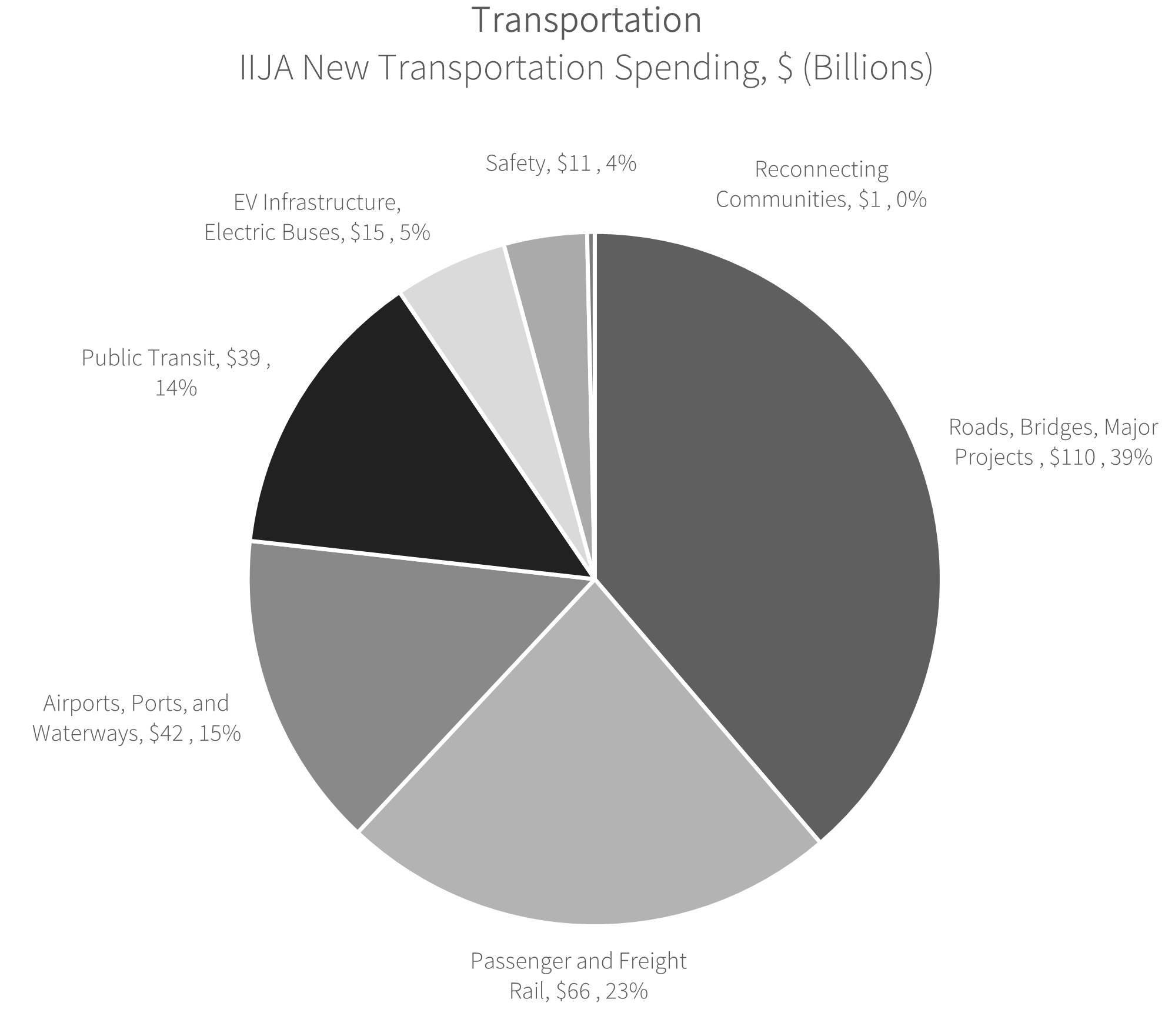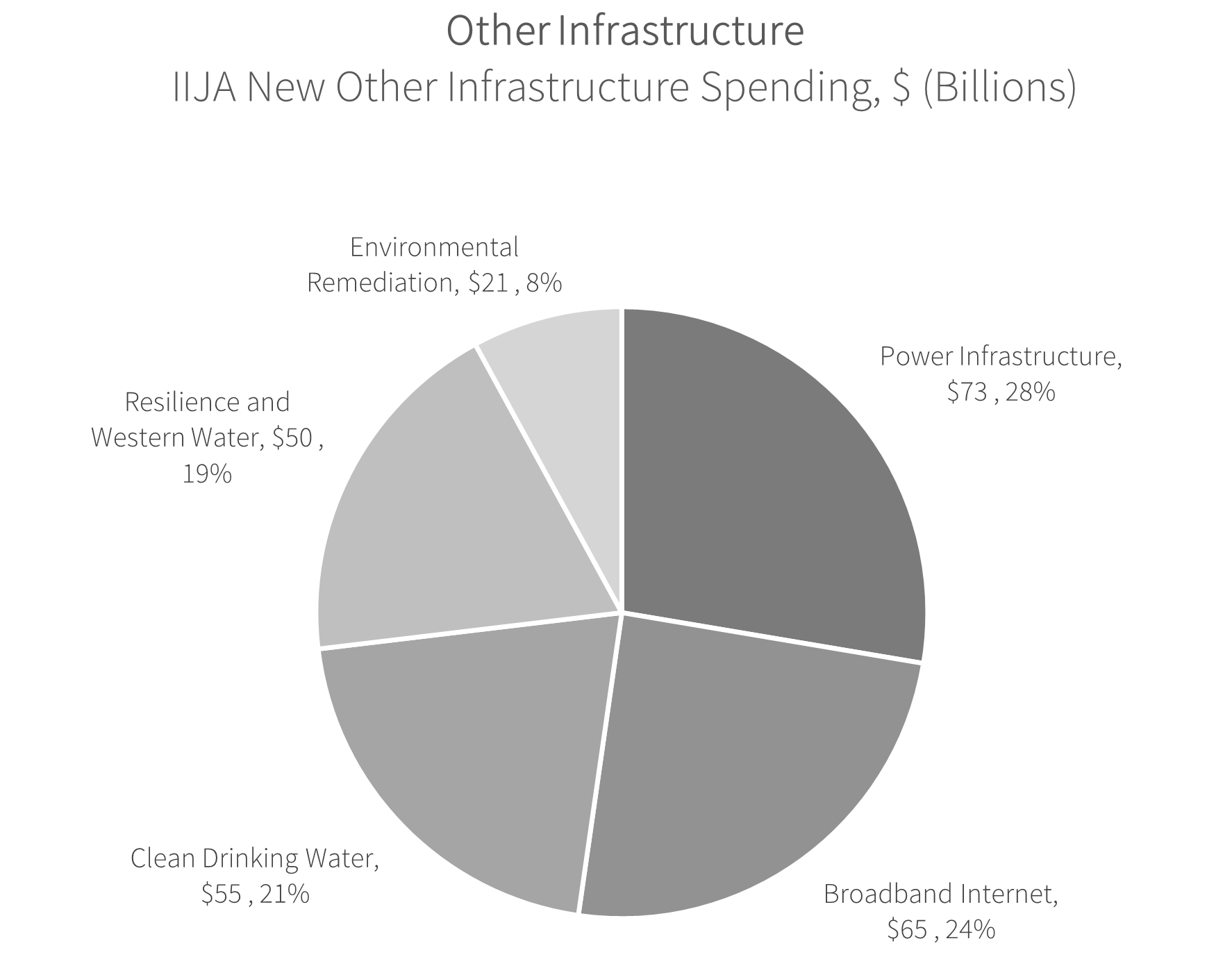
The Infrastructure Investment and Jobs (IIJA) Act 2021 includes $550 billion in new federal investment to address critically needed U.S. infrastructure.
Whether you're interested in funding by state, new spending priorities, or infrastructure type, there's a lot to gain from looking at diverse viewpoints on the IIJA.
As demonstrated in the table below and this article’s breakdown of different perspectives, this bill represents major federal support for public works in the United States across a variety of businesses.

Source: Whitehouse.gov “Fact Sheet: The Bipartisan Infrastructure Deal”
The objective of the IIJA is to grow the economy, create good jobs, enhance the nation’s competitiveness, and make the economy more sustainable and resilient.
The $550 billion in new spending is split between improving the transportation network ($284 billion) and the social infrastructure ($266 billion). The charts below show the breakdown of spending for these two main categories.

Roads, Bridges, and Major Projects
Includes $40 billion of new funding for bridge repair, rehabilitation and replacement which is the single largest dedicated bridge investment since the construction of the interstate highway system
Includes $16 billion for major projects that are too large or complex for traditional funding programs
Passenger and Freight Rail
This is the largest investment in passenger rail since the creation of Amtrack
Funding includes grants to Amtrak, federal-state partnership grants for the Northeast Corridor modernization, grants for intercity rail service and high-speed rail
Airports, Ports and Waterways
$25 billion in airports and $17 billion in port infrastructure to address repair and maintenance backlogs and improve sustainability in port, airport and freight infrastructure
Public Transit
This is the largest Federal investment in public transit history ($39 billion)
EV Infrastructure and Electric buses
$7.5 billion for the first national investment in EV charging infrastructure in the U.S.
$2.5 billion for zero emission buses, $2.5 billion for low emission buses and $2.5 billion for ferries
Safety
This doubles the funding directed to programs to improve the safety of people and vehicles in our transportation system
Reconnecting Communities
This is the first program to reconnect communities divided by transportation infrastructure

Power Infrastructure
This is the single largest investment in clean energy transmission in American history
Broadband Internet
This is a significant investment in broadband infrastructure to ensure that every American will have access to reliable high-speed internet
Clean Drinking Water
This is the largest investment in clean drinking water in U.S. history and includes funding to replace all of the nation’s lead pipes and service lines
Resilience and Western Water Infrastructure
The largest investment in the resilience of physical and natural systems in U.S. history and will make our infrastructure more resilient to the impacts of climate change and cyber attacks
Environmental Remediation
This is the largest investment to address the legacy pollutants that harm the public health of communities and will create good-paying union jobs in hard-hit energy communities
it is up to the state and local agencies to decide what projects to pursue
The White House released fact sheets that summarize the infrastructure issues for each state and emphasize how the IIJA will improve the life of residents by providing funding across various infrastructure industries.
The calculations that determine how much money each state receives is based on various factors such as the state’s population or number of large cities, however it is up to the state and local agencies to decide what projects to pursue.
The ‘Other’ category includes a wide range of more modern infrastructure technology like electric vehicle infrastructure, broadband internet and climate change and cyber-attack resilience. Highways, Bridges, Public Transit, Airports and Water follow more traditional funding paths. State governments benefit since they don’t have to choose just one sort of infrastructure because each ‘bucket’ receives some funding.



